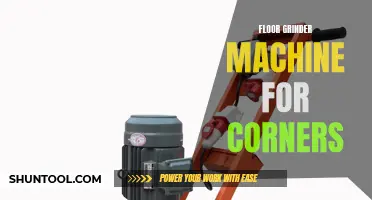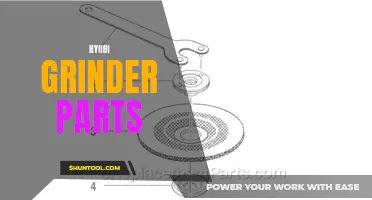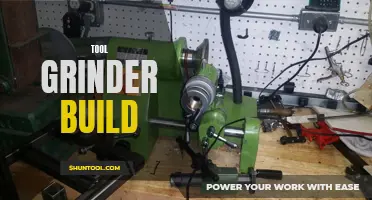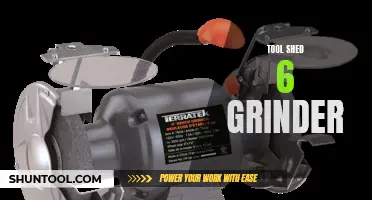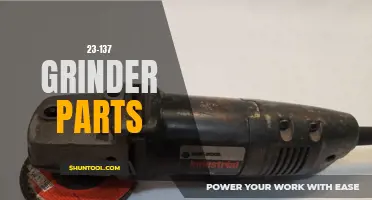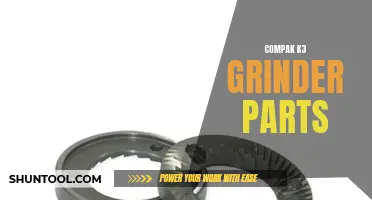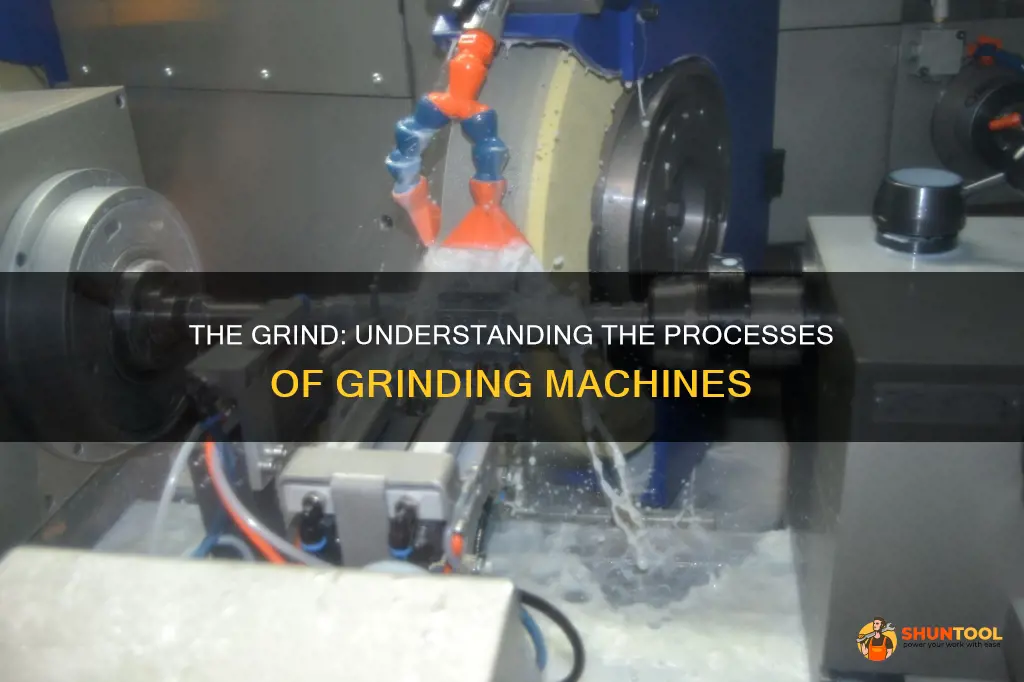
Grinder machines have revolutionized the way we process materials, making the production process faster, more efficient, and more precise. These incredible machines cut, grind, and shape various materials with ease, allowing for the creation of intricate and complex designs. From metalwork to woodworking, the grinder machine process has become an essential part of countless industries, delivering high-quality results that were once impossible to achieve by hand. Whether it's removing excess material, smoothing rough edges, or sharpening tools, grinder machines have become the go-to solution for achieving the perfect finish. So, join me as we delve into the fascinating world of grinder machine process and discover how these powerful tools have transformed and elevated the way we work.
| Characteristics | Values |
|---|---|
| Grinding Method | |
| Grinding Wheel Material | |
| Grinding Wheel Size | |
| Grinding Speed | |
| Grinding Pressure | |
| Grinding Accuracy | |
| Grinding Capacity | |
| Grinding Applications | |
| Power Consumption | |
| Machine Weight | |
| Machine Dimensions |
What You'll Learn

Introduction to Grinder Machine Process
Grinder machines are essential tools in the manufacturing industry, used to shape and finish metal, wood, and other materials with precision and accuracy. They are versatile machines that can perform a variety of tasks, ranging from simple surface grinding to complex internal grinding operations. In this article, we will provide an introduction to the grinder machine process, discussing its various components and operations.
Components of a Grinder Machine:
- Base: The base of a grinder machine provides stability and support to all the other components. It is usually made of cast iron, which ensures rigidity and dampens vibrations during the grinding process.
- Table: The table is where the workpiece is placed and secured during grinding. It can be moved longitudinally and transversely to position the workpiece accurately.
- Wheel Head: The wheel head contains the grinding wheel, which is the main cutting tool in a grinder machine. It can be swiveled to grind workpieces at different angles and can be adjusted vertically to control the depth of cut.
- Spindle: The spindle holds the grinding wheel and rotates it at high speeds. It is driven by an electric motor, and its speed can be adjusted to suit different grinding tasks.
- Work Head: The work head is responsible for supporting and rotating the workpiece during grinding. It can be swiveled to grind tapered or cylindrical workpieces.
Grinder Machine Operations:
- Surface Grinding: Surface grinding is the most common operation performed on a grinder machine. It involves grinding the flat surface of a workpiece to achieve a smooth and accurate finish. This is done using a horizontal spindle and a reciprocating table movement.
- Cylindrical Grinding: Cylindrical grinding is used to grind the cylindrical or tapered surfaces of a workpiece. The workpiece is held in a chuck and rotated while the grinding wheel is traversed along its length. This operation is commonly used for machining shafts, spindles, and other cylindrical components.
- Internal Grinding: Internal grinding is used to finish the internal bores of a workpiece. This is achieved using a small-diameter grinding wheel that is mounted on a spindle and can reach inside the workpiece. Internal grinding is often required to achieve precise dimensions and surface finishes in holes and tubes.
- Centerless Grinding: Centerless grinding is a specialized type of grinding that does not require the use of centers to hold the workpiece. In this process, the workpiece is supported by a regulating wheel and a grinding wheel, which rotates in the same direction but at different speeds. Centerless grinding is commonly used for cylindrical parts without centers, such as bars and tubes.
Grinder machines are versatile tools that play a crucial role in the manufacturing industry. They are used to shape and finish various materials with precision and accuracy. Understanding the components and operations of a grinder machine is essential for anyone working in the field of machining. Whether it is surface grinding, cylindrical grinding, internal grinding, or centerless grinding, all these processes require proper knowledge and expertise to achieve desired results. So, next time you see a grinder machine in action, you will have a better understanding of the intricate process it is performing.
The Importance of Grinder Dressing Machines in Precision Grinding
You may want to see also

Overview of Grinder Machine Components and Functionality
Grinder machines are widely used in various industries for shaping and finishing metals, wood, plastics, and other materials. These machines are designed to remove excess material from workpieces and create a smooth surface or desired shape. Understanding the components and functionality of grinder machines is essential for operating them safely and efficiently.
- Power Source: Grinder machines are typically powered by electricity, compressed air, or gasoline engines. The power source provides the energy necessary for the machine's operation.
- Grinding Wheel: The grinding wheel is one of the most critical components of a grinder machine. It is typically made of abrasive materials like aluminum oxide or silicon carbide. The grinding wheel rotates at a high speed, creating the cutting action needed to remove material from the workpiece.
- Wheel Guard: The wheel guard is a protective cover that encloses the grinding wheel. It prevents sparks, dust, and fragments from flying out during the grinding process, ensuring the safety of the operator. The wheel guard also helps to maintain the proper alignment of the grinding wheel.
- Work Rest: The work rest is an adjustable support mechanism that holds the workpiece in place during grinding. It ensures that the workpiece remains stable and properly positioned, reducing the risk of accidents and achieving accurate results.
- Spark Deflector: A spark deflector is a component located above the grinding wheel. It redirects sparks and debris away from the operator, preventing injuries and maintaining a clean working environment.
- Base and Table: The base and table provide a stable platform for the grinder machine. The base supports the weight of the machine, while the table holds the workpiece and supports its movement during grinding.
- Wheel Dresser: The wheel dresser is a tool used to shape and clean the grinding wheel. It removes any buildup of material on the wheel's surface, ensuring that it remains sharp and efficient.
- Control Panel: Many modern grinder machines feature a control panel that allows operators to adjust various settings and parameters. The control panel may include switches for power, speed control, and other functions, providing convenience and flexibility in operation.
- Coolant System: Some grinder machines are equipped with a coolant system, which is used to reduce heat and friction during the grinding process. The coolant is typically a water-based solution that helps to extend the life of the grinding wheel and improve the surface finish of the workpiece.
- Safety Features: Grinder machines often have a range of safety features to protect the operator from potential hazards. These may include emergency stop buttons, interlocks, and guards. It is crucial to familiarize yourself with these safety features and follow all recommended safety precautions to avoid accidents.
In conclusion, grinder machine components and functionality play a significant role in their operation and performance. Understanding how each component works together ensures safe and efficient operation. Always refer to the machine’s manual and seek proper training before operating a grinder machine to maximize productivity and prevent accidents.
The Best Deals on Grinder Tools in Pakistan
You may want to see also

Step-by-Step Guide to Operating a Grinder Machine
Grinder machines are efficient and versatile tools used in various industries for grinding, cutting, and shaping materials. Whether you are a professional or a DIY enthusiast, operating a grinder machine requires some basic knowledge and skills to ensure safety and achieve optimal results. In this step-by-step guide, we will walk you through the process of operating a grinder machine.
Step 1: Familiarize Yourself with the Grinder Machine
Before starting any operation, it is essential to familiarize yourself with the grinder machine you are working with. Read the user manual provided by the manufacturer to understand the machine's features, safety guidelines, and maintenance requirements. Identify the different components of the machine, including the power switch, grinding wheel, adjustable guard, and work support.
Step 2: Wear Appropriate Safety Gear
Safety should be your utmost priority when operating a grinder machine. Make sure to wear appropriate safety gear, including safety glasses or goggles, a face shield, hearing protection, gloves, and a dust mask. These will protect you from flying debris, sparks, noise, and harmful dust particles generated during the grinding process.
Step 3: Check the Grinding Wheel
Inspect the grinding wheel to ensure it is in good condition. Look for any cracks, chips, or other damages that might cause the wheel to break during operation. It is crucial to use a grinding wheel suitable for the material you are working on. Refer to the wheel's specifications and markings to ensure you are using the correct type and size.
Step 4: Secure the Workpiece
Before turning on the grinder machine, securely mount or clamp the workpiece to a stable surface. Ensure that it is positioned properly, allowing enough clearance for the grinding wheel to move freely and without obstruction. This will prevent any accidents or unexpected movements during operation.
Step 5: Adjust the Grinder Machine's Settings
Depending on the desired outcome, adjust the grinder machine's settings. This may include setting the speed, depth of cut, and grinding angle. Take into consideration the material you are working on and the type of grinding operation you need to perform. Make small adjustments at a time and test the results before proceeding further.
Step 6: Start the Grinder Machine
Once you have completed the necessary preparations, you can now start the grinder machine. Ensure that the power cord is adequately connected and the machine is properly grounded. Turn on the power switch and wait for the grinder to reach its operating speed before proceeding.
Step 7: Begin Grinding
Gently move the workpiece towards the grinding wheel, keeping a firm grip and controlling the movement. Do not force the workpiece into the wheel as this may cause the wheel to become damaged or break. Allow the grinder machine to do the work, and use minimal pressure to achieve the desired result. Move the workpiece back and forth or in a circular motion to evenly grind the surface.
Step 8: Pay Attention to Safety Precautions
During the grinding process, it is crucial to pay attention to safety precautions. Avoid wearing loose clothing or jewelry that may get caught in the grinder machine. Maintain a safe distance from the grinding wheel and always maintain control of the workpiece. If the grinder machine starts vibrating excessively or there is an unusual noise or smell, immediately turn off the machine and inspect for any issues.
Step 9: Inspect and Clean the Machine
Once you have completed the grinding process, switch off the grinder machine and unplug it from the power source. Inspect the grinding wheel for any damages or excessive wear. Clean the machine, removing any debris, swarf, or grinding dust that may have accumulated. Regularly check and clean the work support, adjustable guard, and other components to ensure their proper functioning.
By following this step-by-step guide, you can safely and effectively operate a grinder machine. Remember to always prioritize safety, use the appropriate grinding wheel, and practice proper machine maintenance. With practice and experience, you will become more proficient in using a grinder machine to achieve exceptional results in your projects.
The Ultimate Guide to Using a Tool Head Grinder for Precision Grinding
You may want to see also

Tips and Safety Precautions for Using a Grinder Machine
A grinder machine is a versatile tool that is commonly used in workshops and construction sites. It is designed to grind, polish, and cut metal, wood, and other materials. While it can be a handy tool, it is important to keep in mind some safety precautions when using a grinder machine to avoid accidents and injuries. In this article, we will provide you with some tips to ensure that you use a grinder machine safely.
Tip 1: Read the Manual
Before using a grinder machine, it is essential to read the manual provided by the manufacturer. The manual will contain instructions on how to properly and safely operate the machine. It will also provide you with information on the machine's capabilities, maintenance, and potential hazards. Familiarize yourself with the manual to make sure that you understand the proper use of the grinder machine.
Tip 2: Wear Personal Protective Equipment (PPE)
When using a grinder machine, it is crucial to wear the appropriate personal protective equipment (PPE). This includes safety glasses or goggles, earplugs or earmuffs, a face shield, gloves, and a dust mask or respirator. The PPE will protect you from flying debris, sparks, loud noise, and inhaling dust or fumes. Always make sure that your PPE fits properly and is in good condition.
Tip 3: Inspect the Grinder Machine
Before using the grinder machine, inspect it for any damages or defects. Check the power cord for any frays or cuts, and make sure that the plug is properly grounded. Examine the grinding wheel for any cracks or chips. A damaged wheel can shatter during use and cause serious injuries. If you notice any issues with the grinder machine, do not use it and have it repaired or replaced.
Tip 4: Secure the Workpiece
When using a grinder machine, always secure the workpiece before starting the grinding process. This can be done using clamps, a vise, or any other appropriate tool. Securing the workpiece ensures that it doesn't move or fly off during operation, reducing the risk of accidents.
Tip 5: Properly Position Yourself
When using a grinder machine, it is crucial to position yourself properly. Stand in a stable and balanced position with your feet shoulder-width apart. This will provide you with better control over the machine and reduce the chance of losing balance. Make sure that there are no obstacles or tripping hazards in your working area.
Tip 6: Use the Correct Wheel
Ensure that you are using the correct wheel for the material you are grinding or cutting. Different wheels are designed for different purposes, and using the wrong one can result in accidents. Pay attention to the speed rating and size of the wheel, and select the appropriate wheel for your application.
Tip 7: Start Slowly
When starting the grinder machine, always begin at a slow speed to allow for control and adjustment. Gradually increase the speed as you become more comfortable with the tool. Abruptly starting at a high speed can cause the grinder to kickback or the workpiece to be thrown off.
Tip 8: Maintain Control
Always maintain a firm grip on the grinder machine during operation. Keep both hands on the handles and avoid any distractions that may cause you to lose control. Do not force the grinder machine, as this can lead to accidents. Let the machine do the work and guide it smoothly along the surface.
Tip 9: Cool Down the Grinder Machine
After using the grinder machine, allow it to cool down before storing it. Grinding generates heat, and a hot machine can be a safety hazard. Never leave a running grinder unattended and always unplug it after use.
Using a grinder machine can be a time-saving and efficient way to accomplish various tasks. However, it is essential to prioritize safety when operating this powerful tool. By following the tips and safety precautions outlined in this article, you can ensure that you use a grinder machine safely and reduce the risk of accidents and injuries. Remember to always refer to the manufacturer's manual for specific instructions and recommendations for your grinder machine model.
The Power of an Accurate Diamond Tool Grinder for Precision Grinding
You may want to see also
Frequently asked questions
A grinder machine is a tool used for grinding, cutting, or polishing materials.
A grinder machine works by rotating an abrasive wheel or disc at high speeds to remove material from a workpiece.
There are various types of grinder machines, including angle grinders, bench grinders, surface grinders, and cylindrical grinders.
The purpose of a grinder machine is to shape, sharpen, or smooth materials, such as metal, wood, or concrete.
When using a grinder machine, it is important to wear safety goggles, gloves, and a dust mask. Additionally, the machine should be securely mounted and the workpiece should be held firmly.


